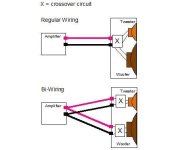I've had my Pink Triangle Ventrical speakers for about 25 years now (bought second hand) outlasting many other much fancier/expensive speakers - usually due to the bigger speakers taking up too much precious room, not that the Pink's don't sound good.
I've always used them with single runs of speaker wire (nothing rubbish) and thought they were very musical and enjoyable, which is probably why I keep coming back to them.
I recently thought I'd move them on in an attempt to rationalise some of the hoard of hi-fi I've accumulated.
I rooted out a pair of MIT MH750 shotgun speaker cables that had been in need of new banana plugs and got them done professionally.
I then decided to try the newly terminated cables with the Pink Triangles - I'd never bi-wired them before.
The speakers suddenly have a new/better focus and clarity than I ever remember them having.
I'm wondering if the crossovers are completely bypassed when bi-wiring the speakers?
It's also made me think the crossovers, which must be in use when single wired, need to be recapped.
Or could it just be the massive cables and built in crossover networks controlling the speakers better...improving the clarity.
I've recently had some old equipment upgraded (Quad 303 and Revox B225 cd player) and have been amazed at the difference recapping makes.
It seems to have improved the clarity and grip on the music in both cases, I'm thinking it might be worth getting the crossovers checked over?
Anyone have any knowledge of how the crossovers work when bi-wiring?
Also any suggestions regards the benefits of recapping crossovers.
I'm now thinking I might keep the Pinks a bit longer, as they are so musical!!!
Thanks in advance.
I've always used them with single runs of speaker wire (nothing rubbish) and thought they were very musical and enjoyable, which is probably why I keep coming back to them.
I recently thought I'd move them on in an attempt to rationalise some of the hoard of hi-fi I've accumulated.
I rooted out a pair of MIT MH750 shotgun speaker cables that had been in need of new banana plugs and got them done professionally.
I then decided to try the newly terminated cables with the Pink Triangles - I'd never bi-wired them before.
The speakers suddenly have a new/better focus and clarity than I ever remember them having.
I'm wondering if the crossovers are completely bypassed when bi-wiring the speakers?
It's also made me think the crossovers, which must be in use when single wired, need to be recapped.
Or could it just be the massive cables and built in crossover networks controlling the speakers better...improving the clarity.
I've recently had some old equipment upgraded (Quad 303 and Revox B225 cd player) and have been amazed at the difference recapping makes.
It seems to have improved the clarity and grip on the music in both cases, I'm thinking it might be worth getting the crossovers checked over?
Anyone have any knowledge of how the crossovers work when bi-wiring?
Also any suggestions regards the benefits of recapping crossovers.
I'm now thinking I might keep the Pinks a bit longer, as they are so musical!!!
Thanks in advance.



